These photos are from the Boon Khao Kam (บุญเข้ากรรม) ceremony at Ban Khok Nong Waeng, Amphoe Non Daeng, Nakhon Ratchasima Province between November 29 and December 10, 2019. Thanks to everyone there, especially Phra Khru O-Pat, Phra Bunserm, Phra Apichat, Mae Wanni, and Mae Un, for being so helpful and welcoming me at the temple for ten days. For more information, there’s an explanation of Boon Khao Kam and an overview of heet sip-song, the twelve Isan merit-making traditions.
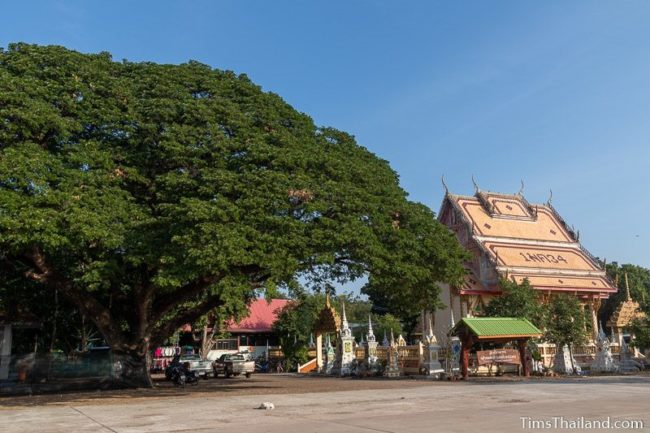
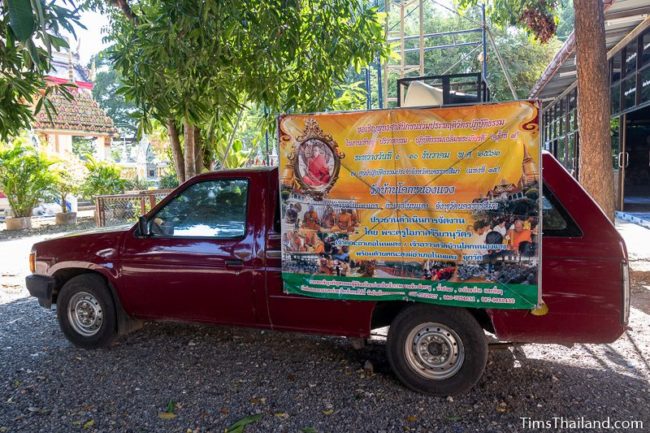
Fifty-six monks from about 30 temples came to attend Boon Kao Kam, which here is called the formal pariwatsakam (ปริวาสกรรม) or the shorter pariwat. Most of these monks (called phra pariwat – “pariwat monks”) came from temples in Amphoe Non Daeng and they chose Wat Ban Khok Nong Waeng because of its proximity. But some traveled from other places including Roi Et, Chantaburi, Phetchabun, and Rayong provinces. The monks from far away came for varied reasons. One came because he grew up here; some knew and respected the abbot, Phra Khru O-Pat; and some just wanted to go and see somewhere new. One of the temple’s resident monks told me he suspects many chose Wat Ban Khok Nong Waeng because they get to eat two meals rather than the usual single meal served during Boon Khao Kam. Another monk, who had eaten only a morning meal during his own Boon Khao Kam assembly, told me the two-meal plan is better because when you’re hungry it’s hard to concentrate during the evening meditation sessions. The monks joining Boon Khao Kam remained inside the temple the whole time.
It must be noted that not all the pariwat monks had necessarily broken any monastic rules; some monks join because the retreat experience provides a chance to make merit or focus their minds. As Phra Apichat, the monk who led the confessional meetings said, “Pariwatsakam is like taking a shower. Sometimes you take a shower because you are dirty; sometimes you take a shower because it feels good.”
Another dozen monks, also from other temples, came to help the abbot lead the Buddhist activities while other monks, mostly from this temple, coordinated things during the day.
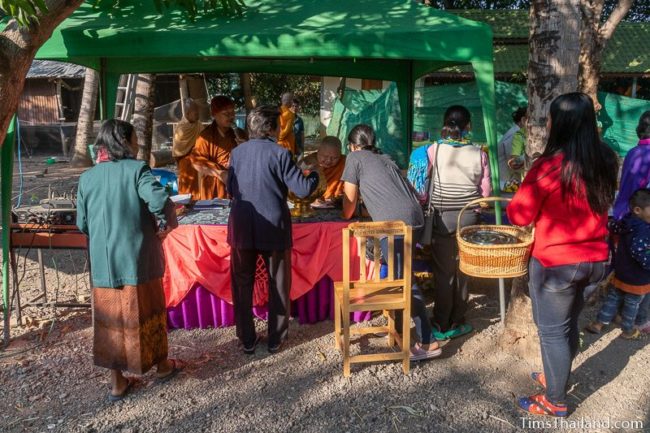
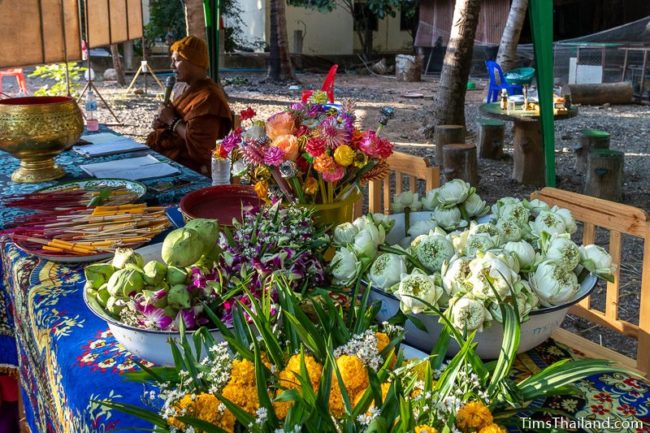
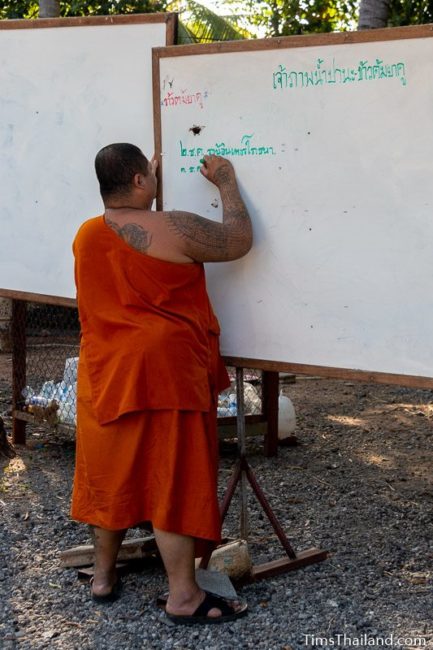
There were also dozens of mae khao and paw khao merit-makers wearing white and following eight precepts (no eating after noon, no entertainment, not sleeping in a comfortable bed, etc.). They did the same activities as the monks except for the confession and purification parts. There were between thirty and fifty each day and about twenty stayed for all ten days.
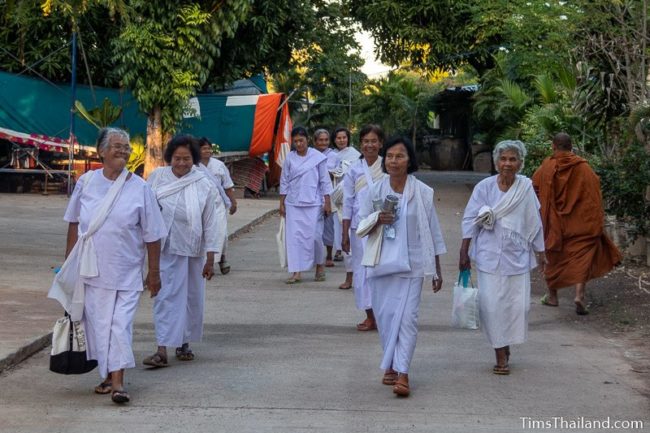
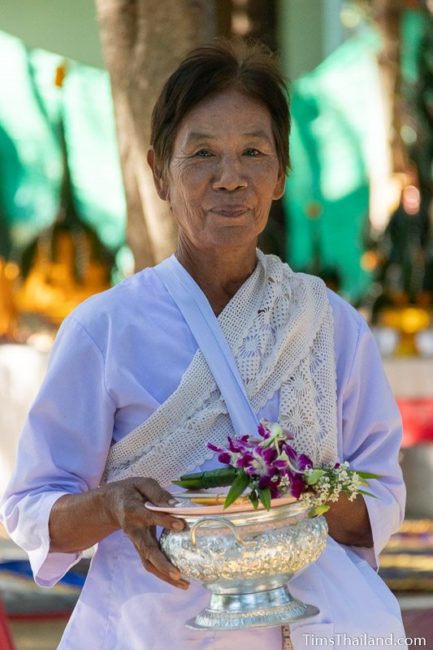
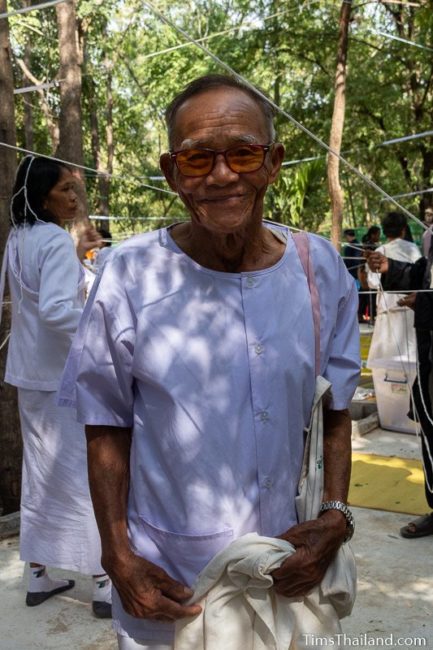
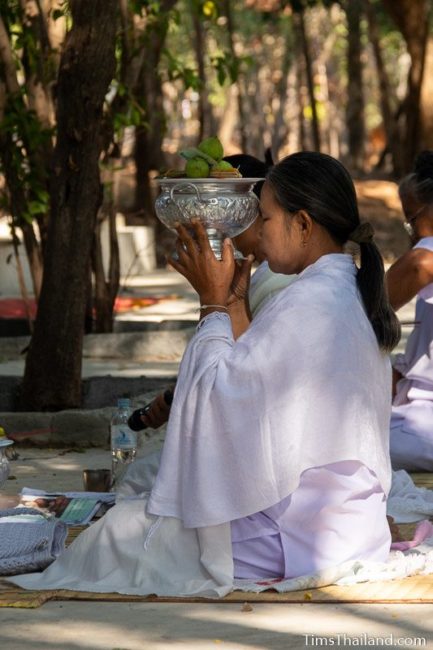
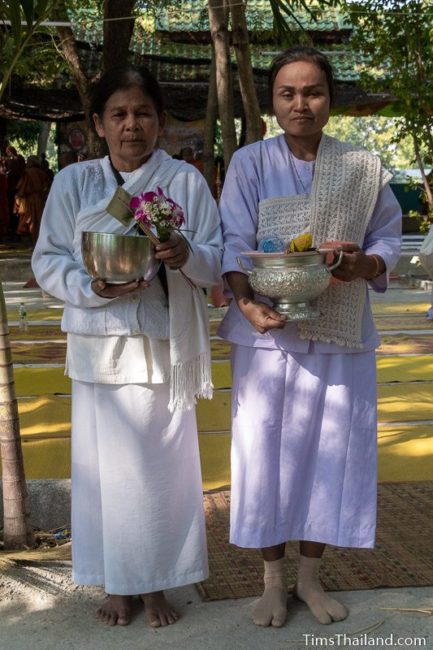
Preparation
Most of the set-up was done on November 29, two days before Boon Khao Kam kicked off, though the straw covering the lahn-tam (“dharma yard” – the outdoor area where most of the activities took place) was delivered by people from various villages over several days before this. Buddha statues were brought out, fabric was folded into beautiful decoration, and several loudspeakers were installed.
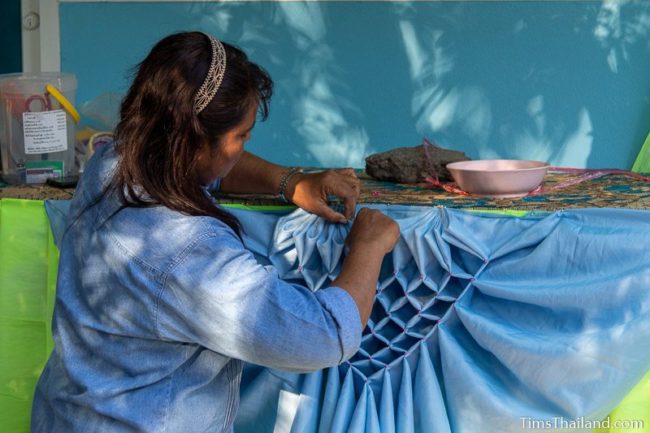
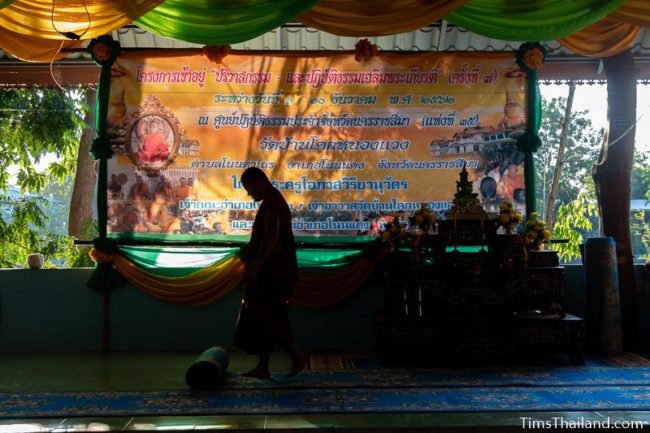
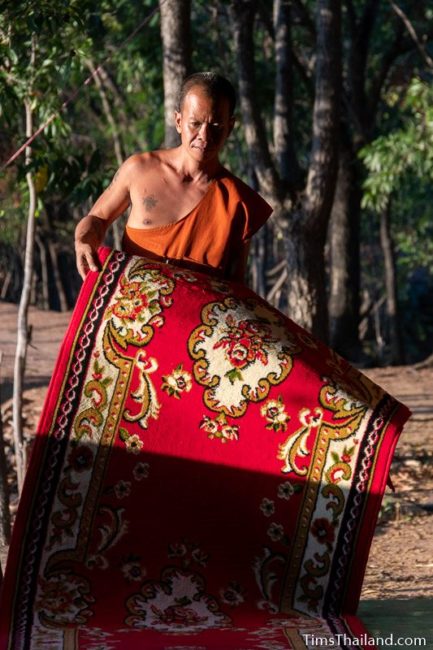
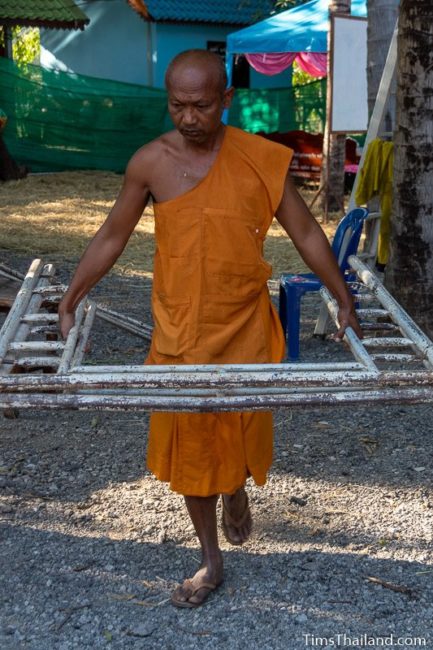
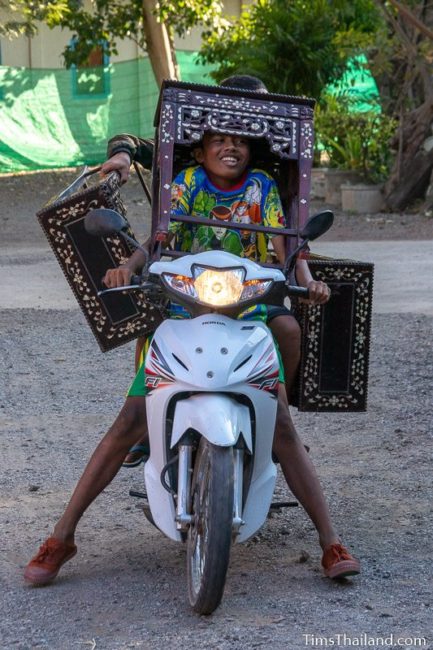
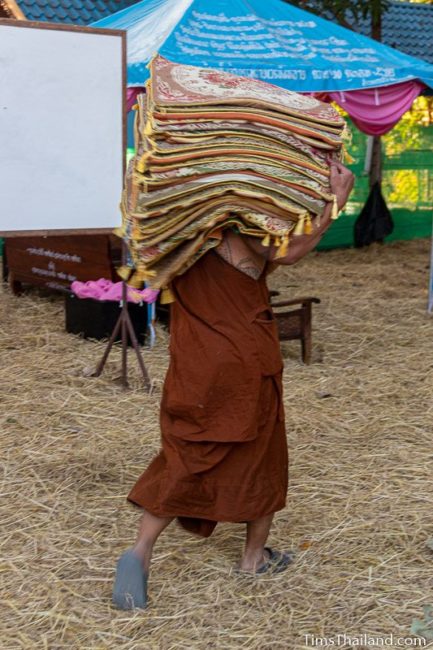
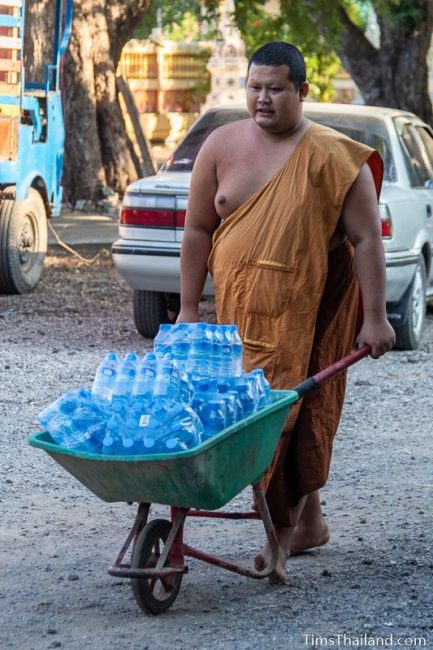
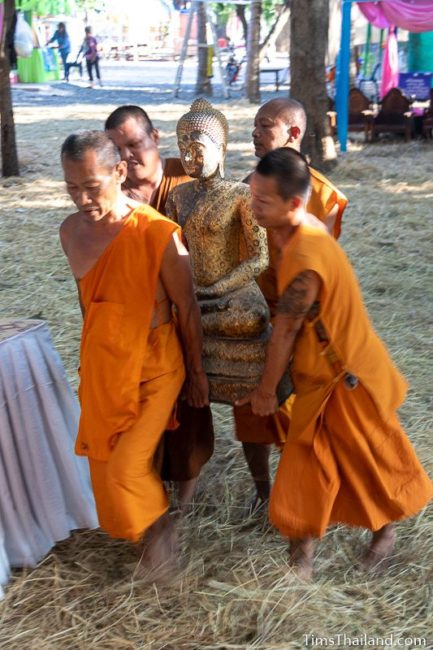
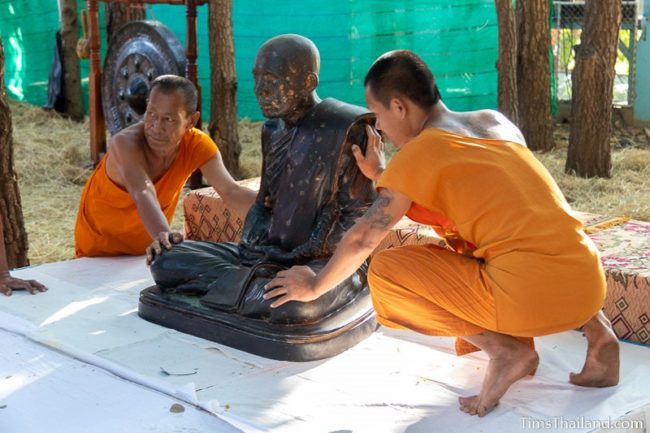
In the evening, a group of people came to the temple to assemble the many banana-leaf bai sii that would decorate a temporary shrine set up in the lahn-tam. Most of the leaf folding had been done before hand.
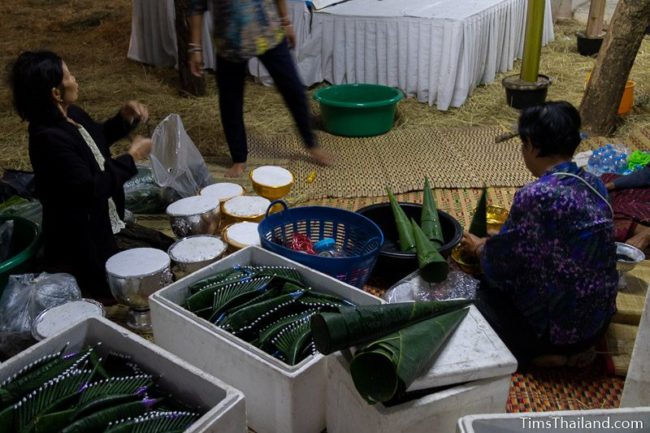
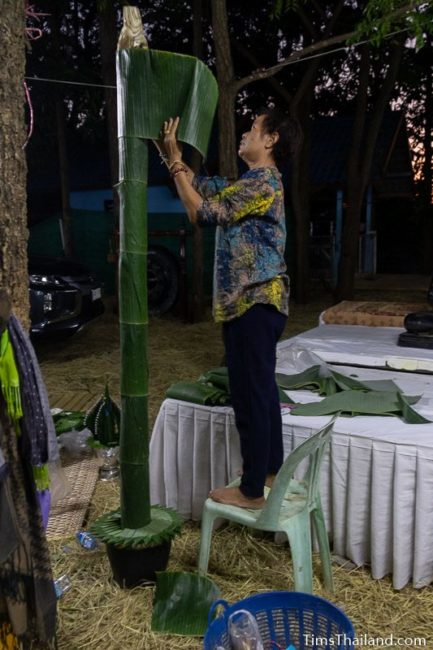
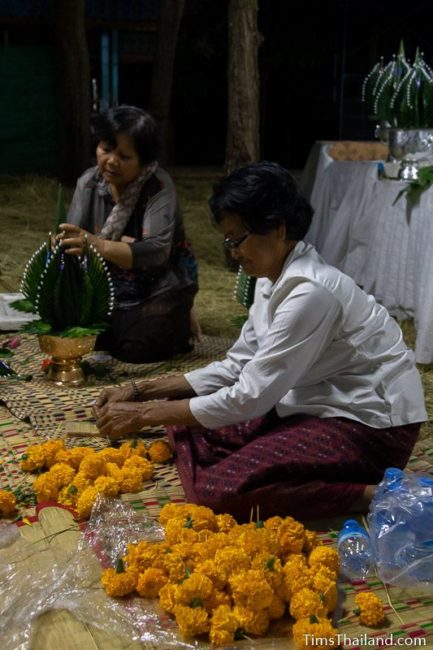
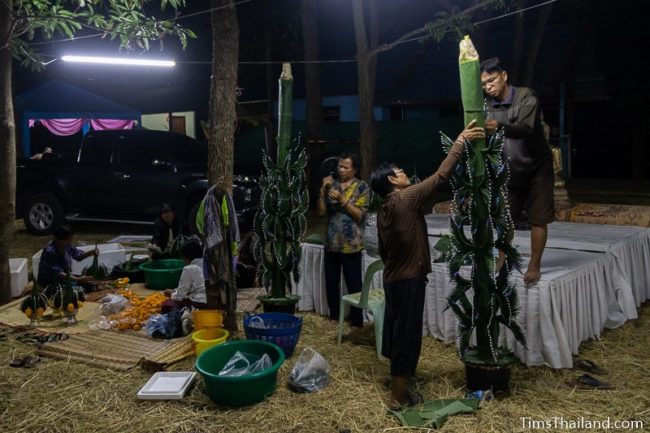
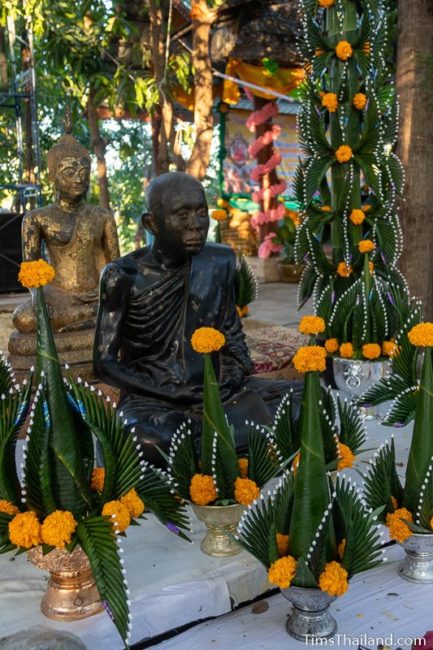
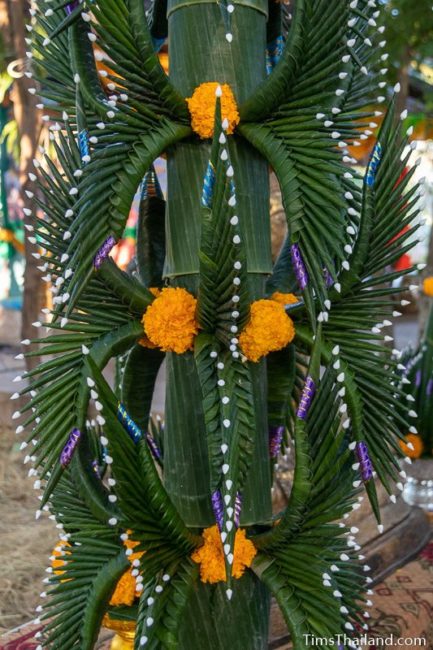
The Day Before Boon Khao Kam
Most of the Boon Khao Kam participants arrived this day, though a few would come the next. The pariwat monks set up a little tent city inside a mesh-walled enclosure – called the pa pariwat (“pariwat forest”) – at the back of the temple. This area provided symbolic solitude and was closed to women for all ten days. The helper monks had their own smaller camping area around the old ubosot.
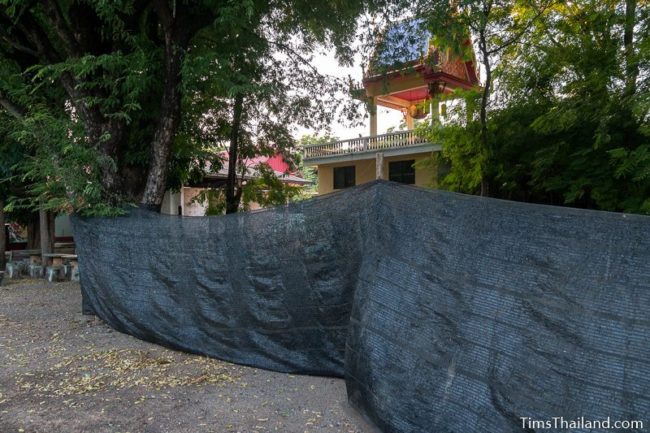
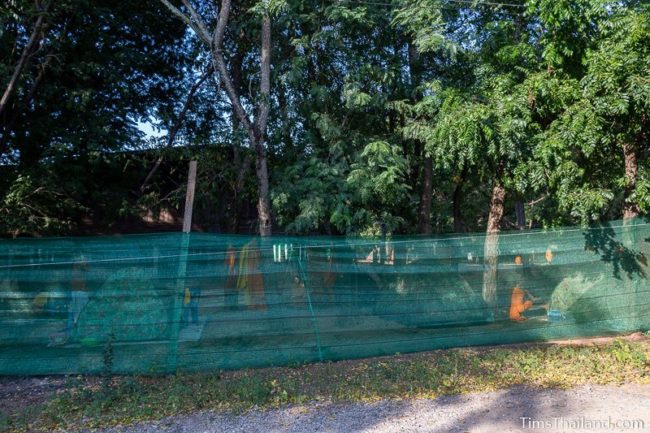
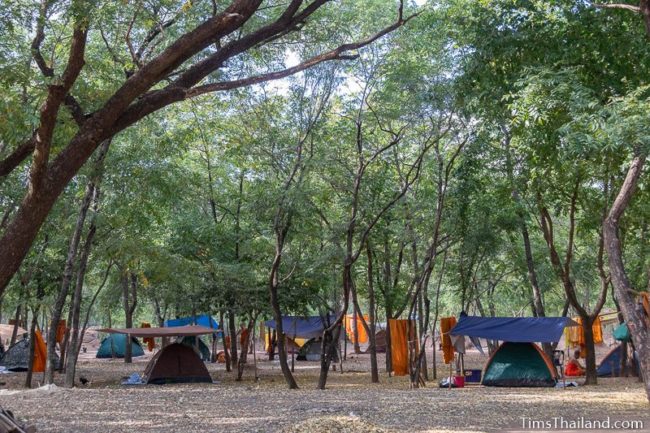
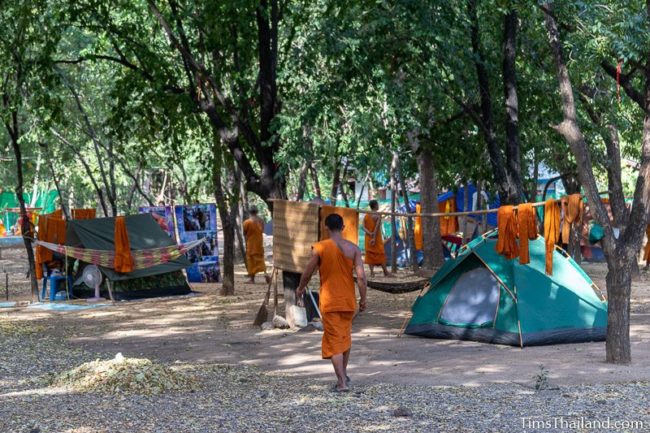
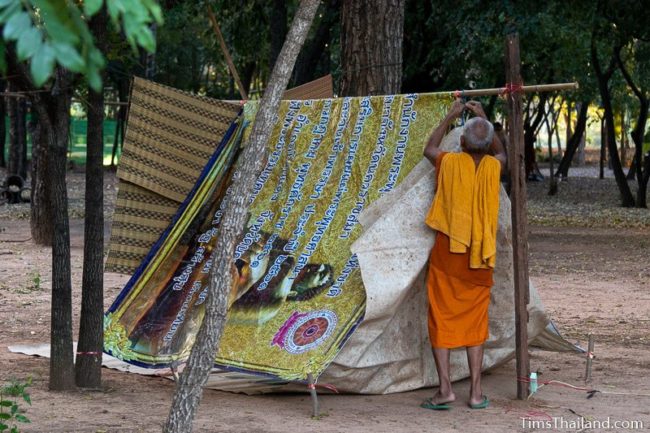
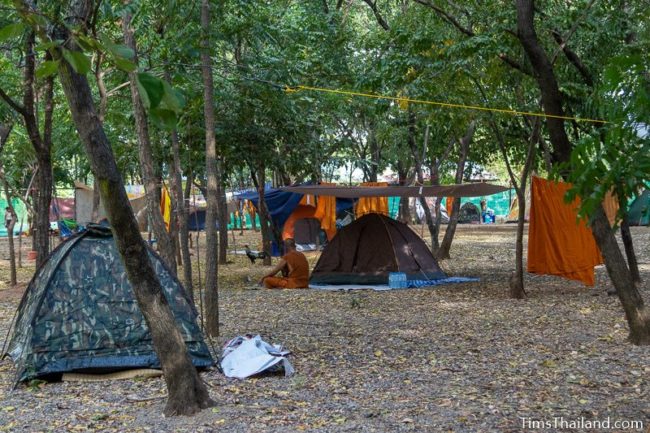
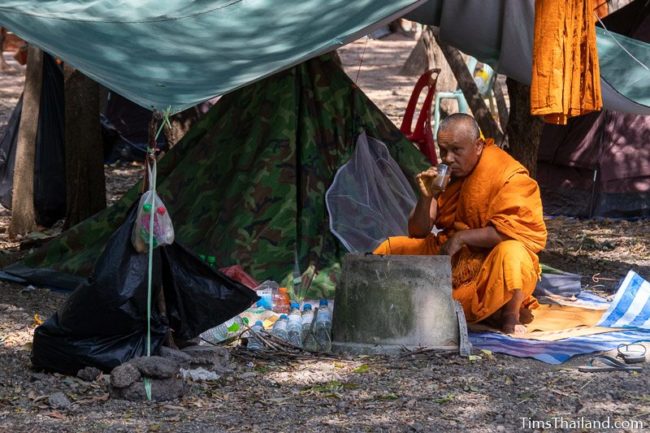
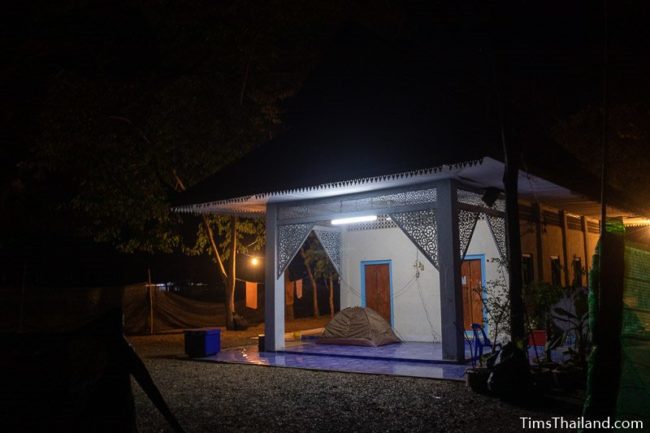
Most mae/paw khao staying long-term also arrived this day. They put up their tents inside two salas, one for the women and another for the men.
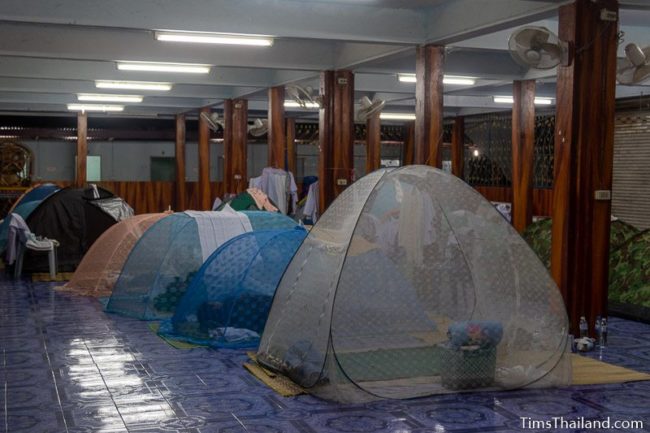
Also coming to the temple were a dozen vendors who set up a small market selling a variety of religious and practical items like amulets, Buddhist books, camping gear, phone chargers, and herbal medicines. About half stayed for just two days and the rest left slowly over the next few days with the last, an amulet seller, departing on day eight.
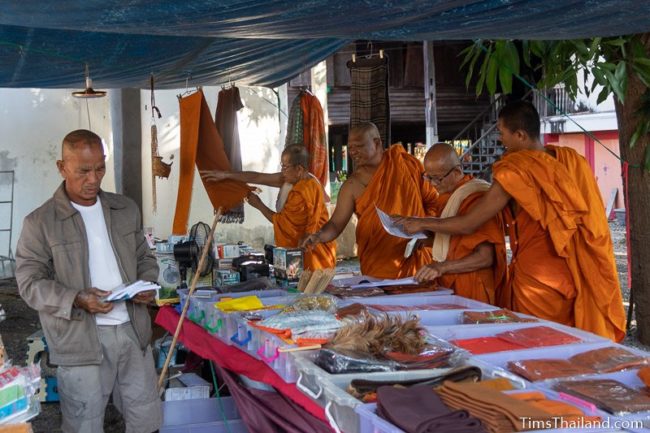
This day there were two ceremonies that though not a part of Boon Khao Kam were very important. Shortly after the morning meal, a ceremony with candles, incense, chanting, and food offerings was done to pay respect to and request the blessing and protection of this event from Luang Pu Nuu, a venerated former abbot whose statue was moved to the lahn-tam for the duration. And any ghosts living at the temple were asked to leave and come back after Boon Khao Kam. Candles and incense were lit for him (as well as others in front of the nearby Buddha image) again every morning.
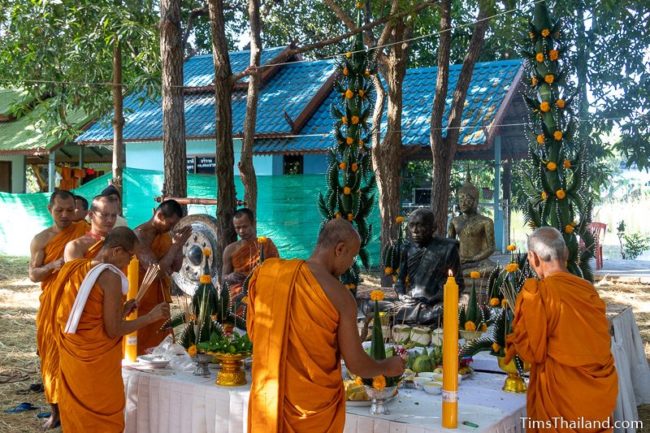
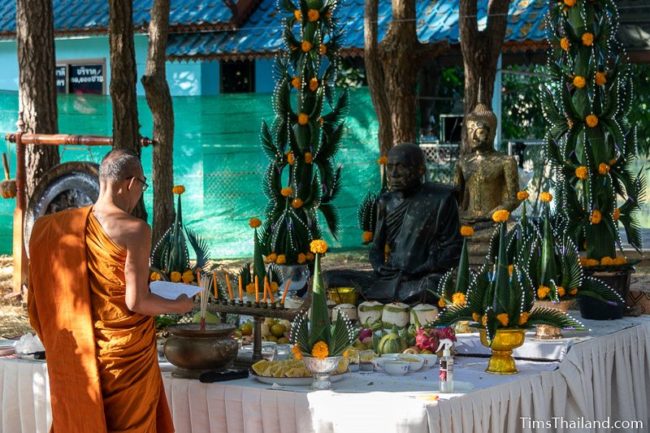
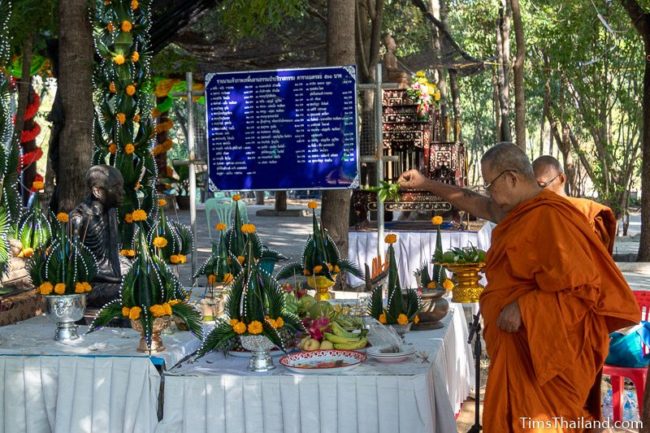
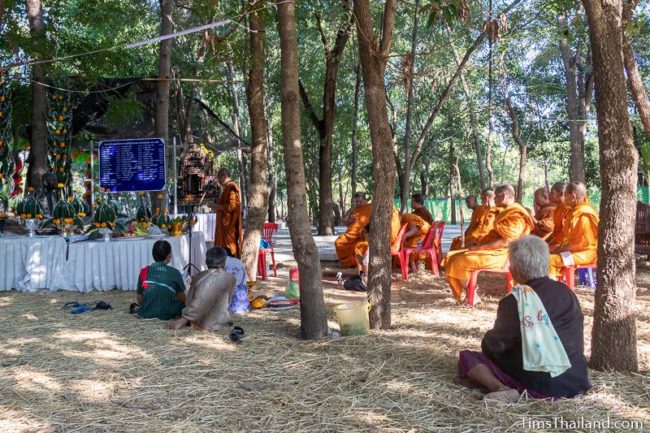
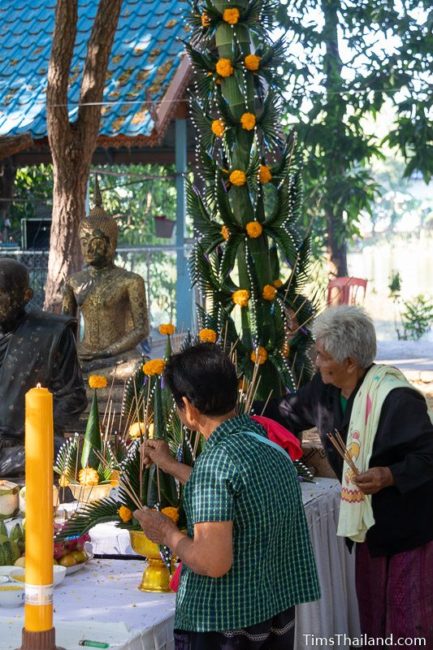
A little later that morning, two men came to Wat Ban Khok Nong Waeng to ordain as monks – one just for the next ten days, the other considering doing it long-term. The full ordination process, which differs quite significantly place to place, deserves a post of its own someday, but here I’ll just briefly discuss the parts that happened at the temple on this day.
First the naak (as men entering the monkhood are known) had their hair and eyebrows shaved and they put on the traditional light, white robes.
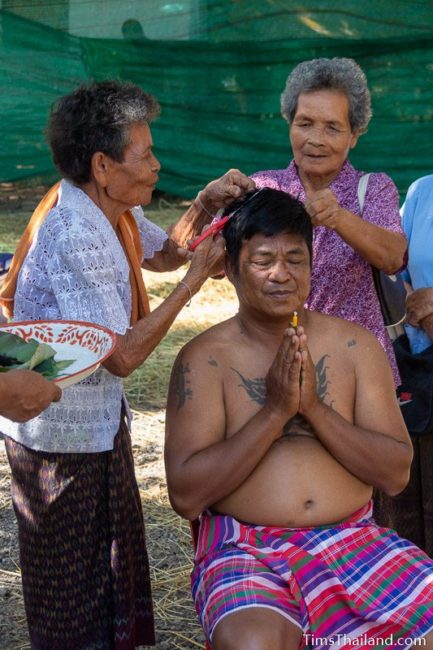
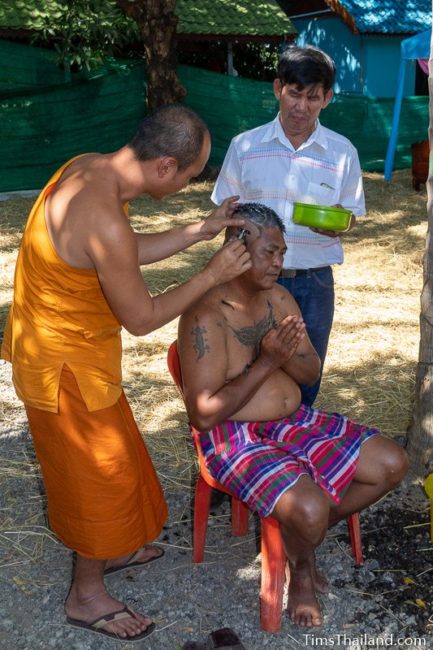
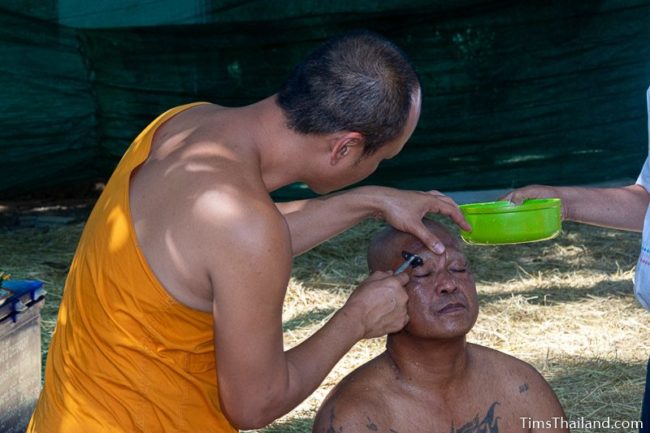
Then they went through a purification ceremony with a maw kwan (shaman) and her two female assistants. One unique aspect of her ritual was erecting a seven-level bamboo pole with various snacks: rice crackers, hard-boiled eggs, kanom krok (coconut pancakes), bananas, and khao tom mat (a steamed banana-leaf-wrapped snack made of sticky rice and banana). The naak would choose one of these as their final food as lay men and this would predict how long he would remain as a monk – the khao tom mat, for example, indicates a long time because it’s sticky. The ceremony finished, as many Isan ceremonies do, with tying sai sin (“sacred threads”) around the men’s wrists to ensure their kwan (“lifeforce energy”) did not wander away from their bodies.
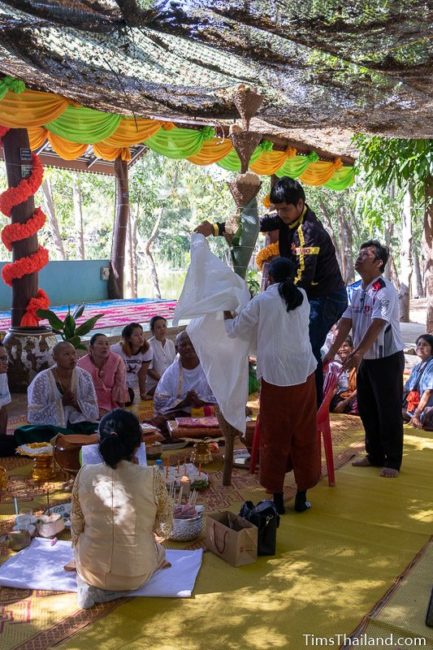
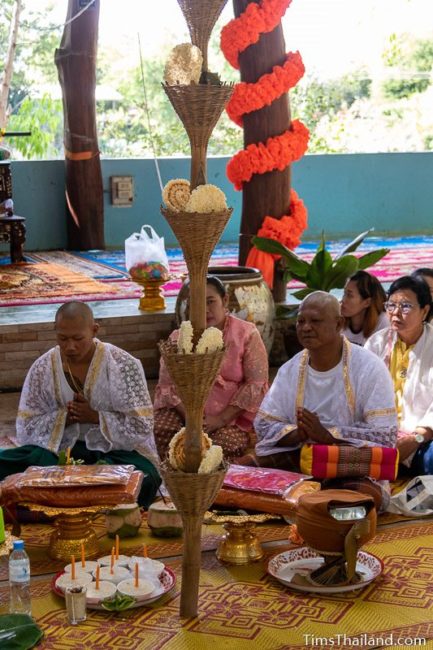
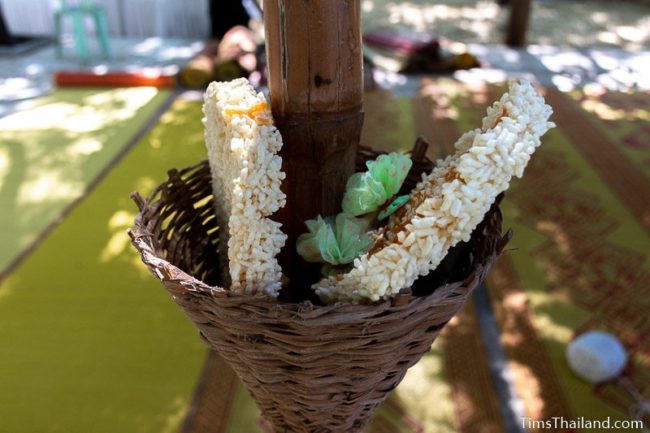
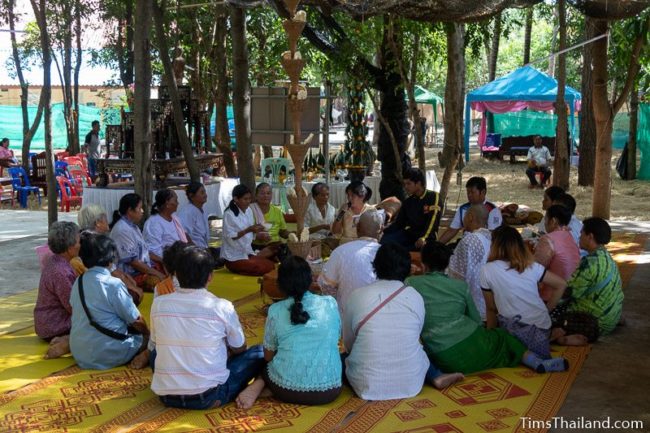
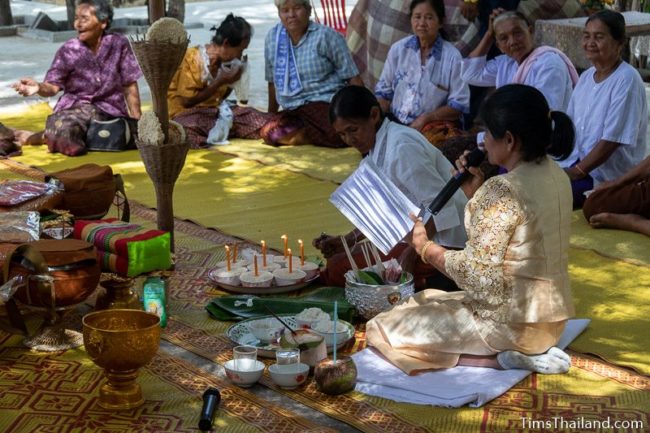
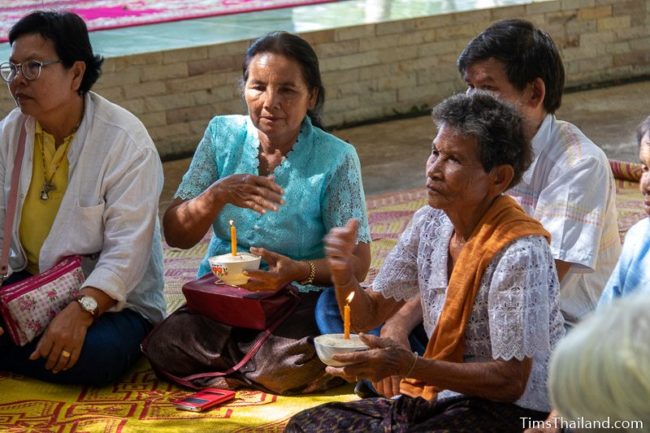
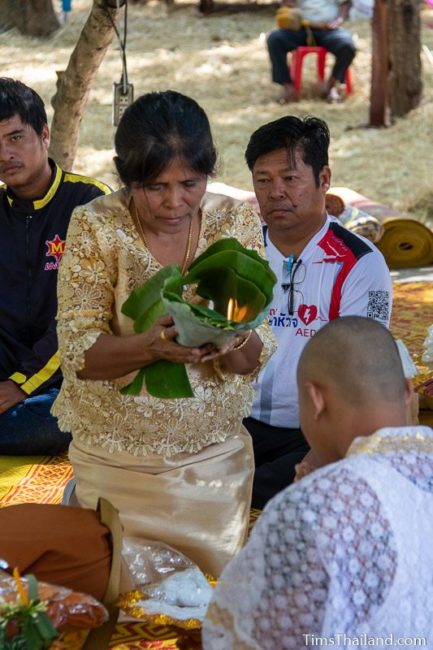
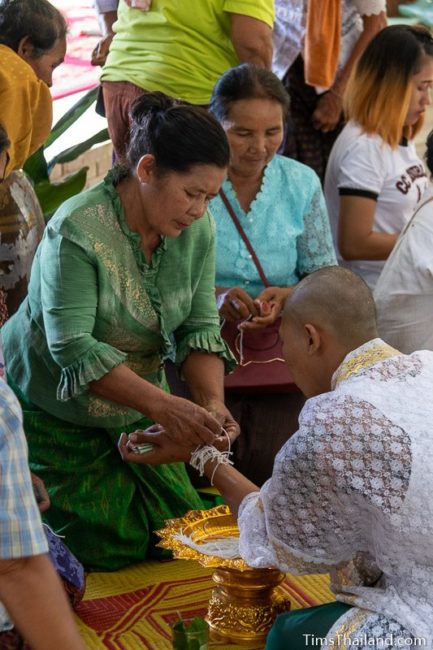
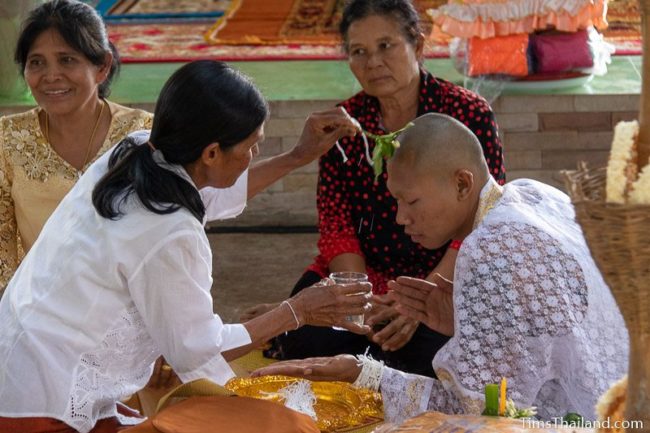
Next the naak walked with their family and friends around the ubosot three times, throwing little coin packets for people to grab, and then went inside where the temple’s monks were waiting.
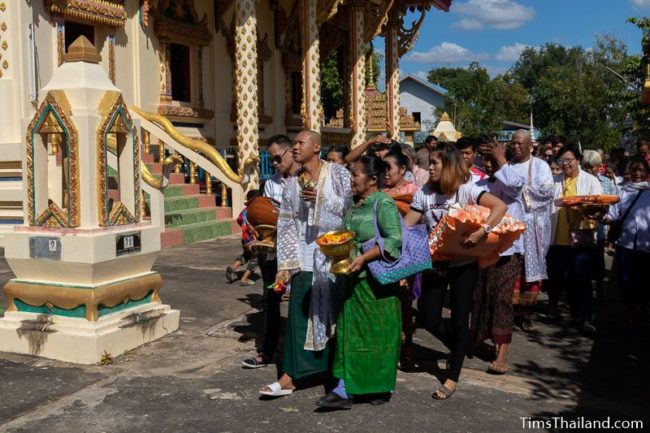
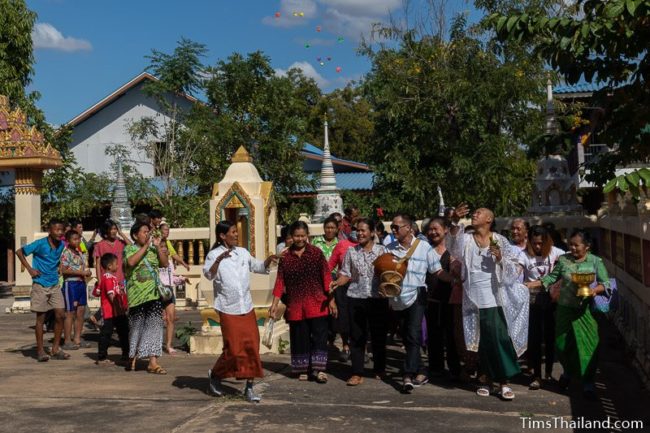
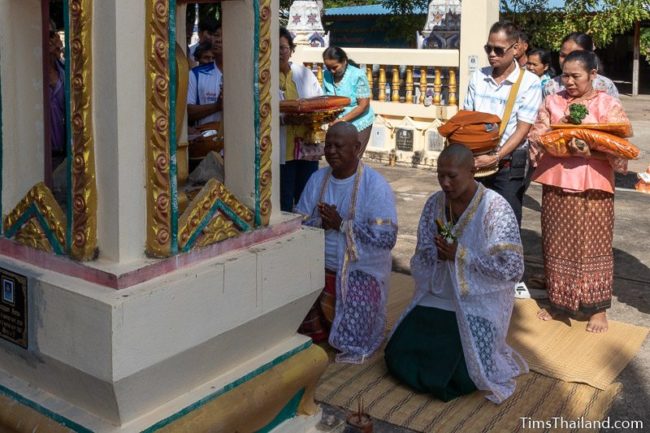
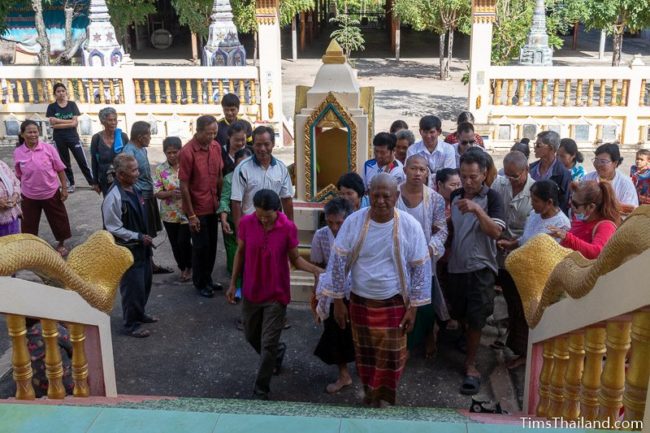
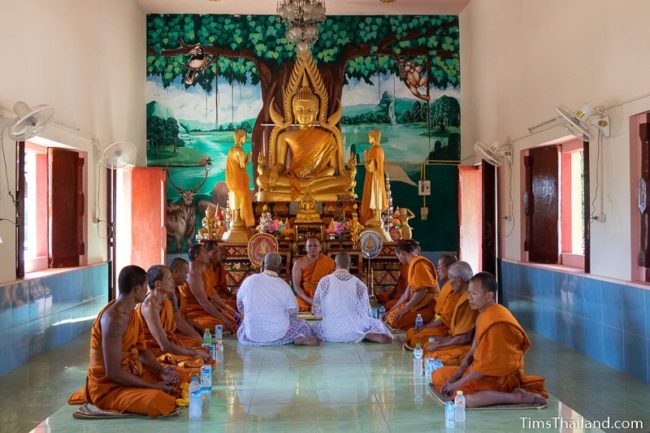
The naaks’ families gave them a robe and bowl and they went outside where a monk helped them change clothes. (Putting on robes correctly is not easy and it takes most monks a long time to get used to it.)
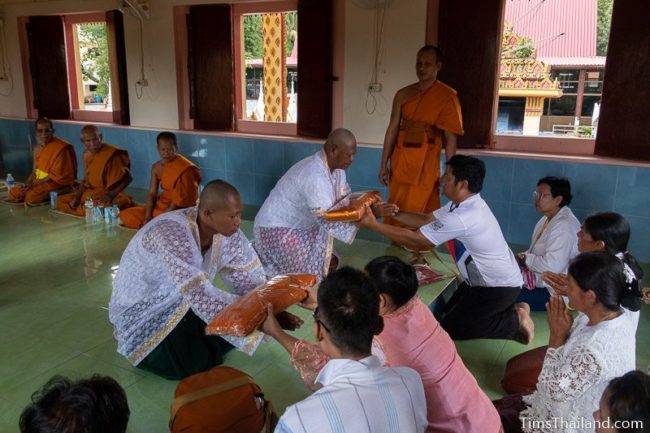
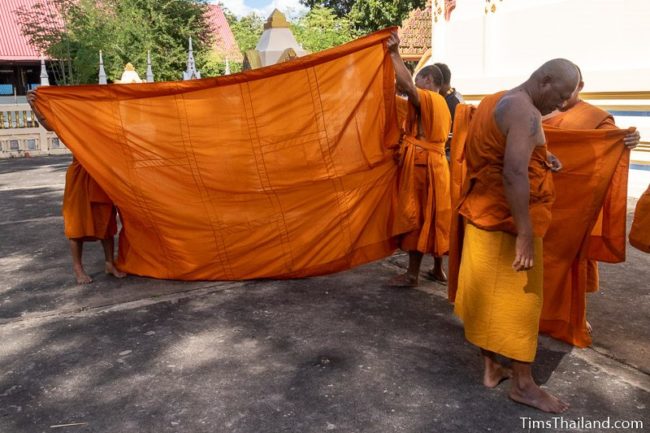
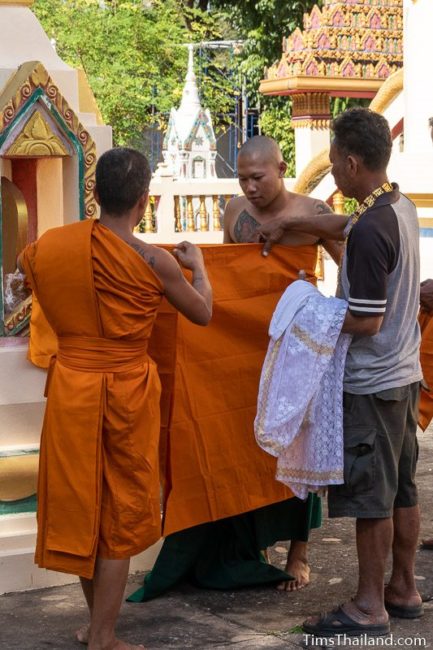
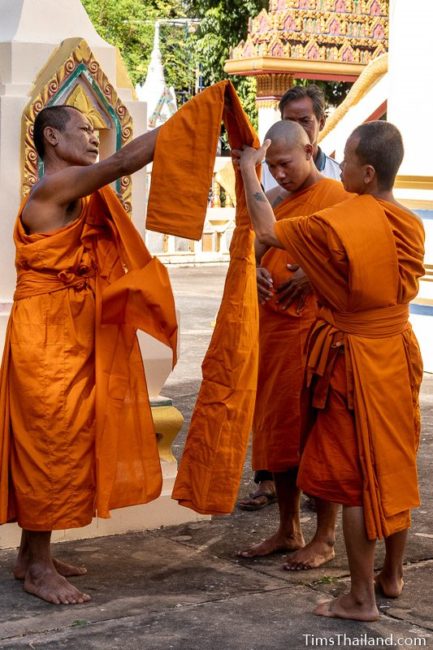
Back inside, the naaks paid respect to their parents and then a short monks-only meeting began, which involved each man answering thirteen questions, including whether they were 20 years old, healthy, and human.
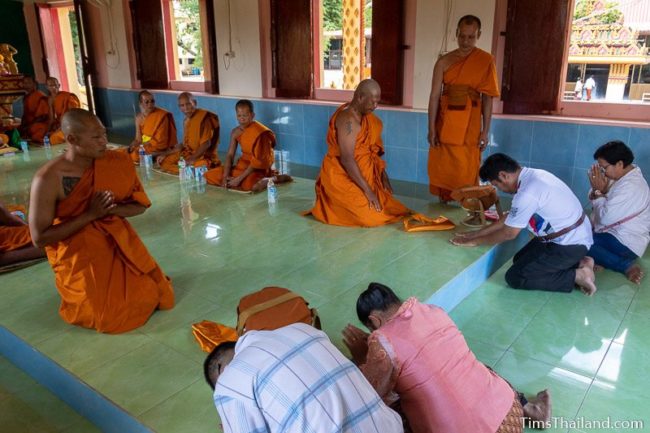
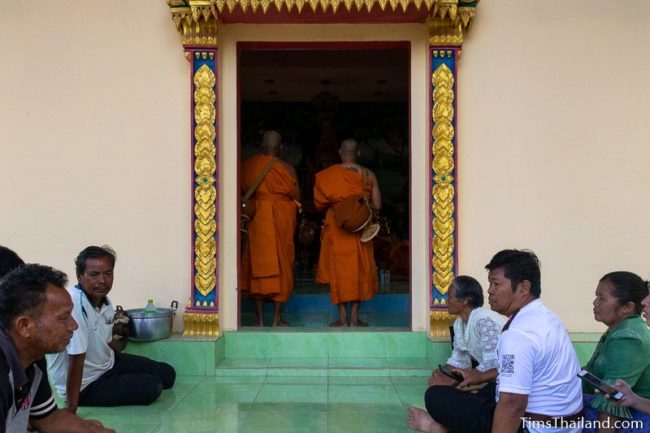
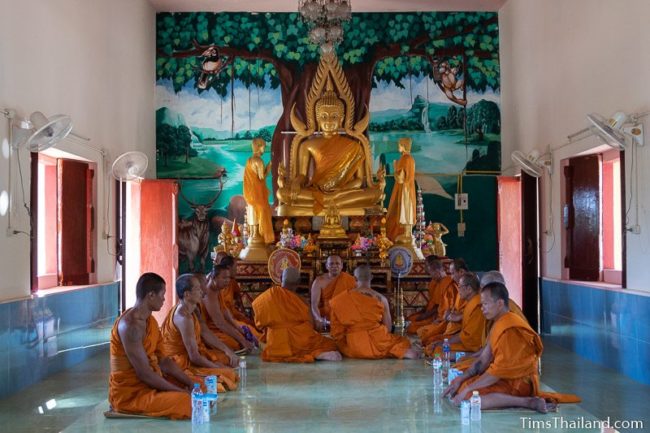
Day 1 – The Start of Boon Khao Kam
Even though Boon Khao Kam hadn’t yet formally begun, breakfast on the first day (December 1) was a special affair simply because there were so many monks to feed. The cooks started preparing food (almost all food served during the ten days was donated) at 4am, though much chopping and peeling had been done the day before. The pariwat monks ate at tables outside rather than in the regular sala with the other monks.
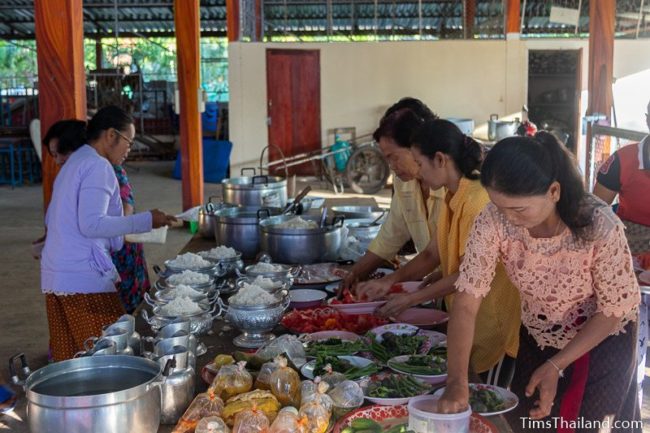
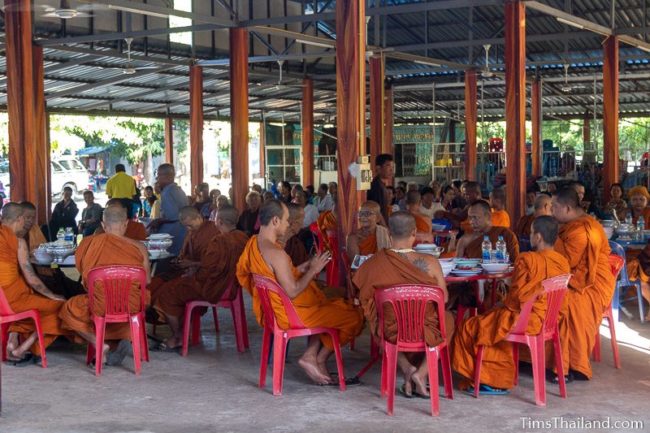
After breakfast the pariwat monks registered at a table set up to serve as the Boon Khao Kam HQ. Besides their names, they wrote down when they had ordained because most activities were done by seniority.
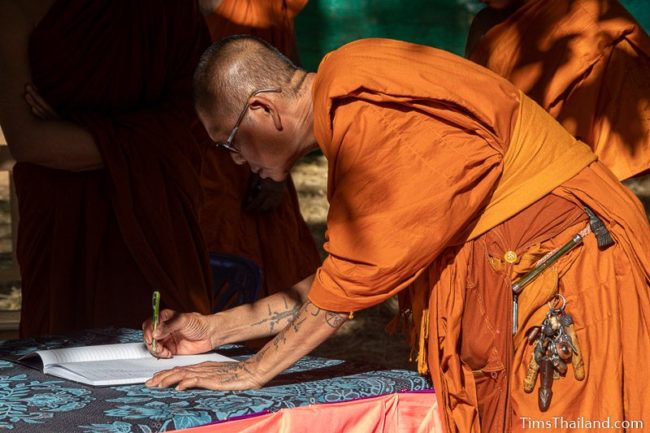
Then they all gathered into the ubosot (ordination hall) for a short monks-only meeting (Nobody else was even allowed inside the surrounding wall.) led by a group of five monks called the sangka.
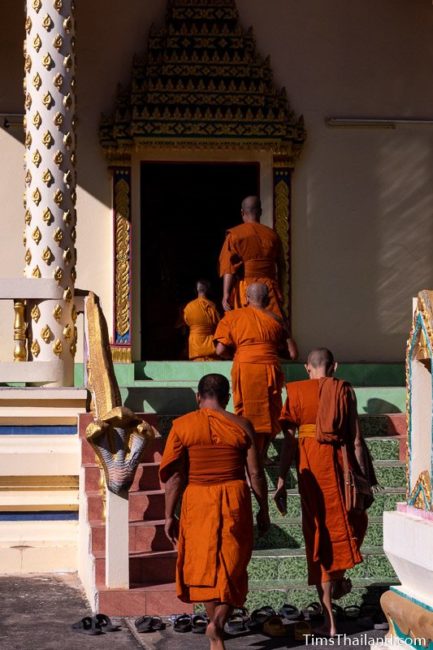
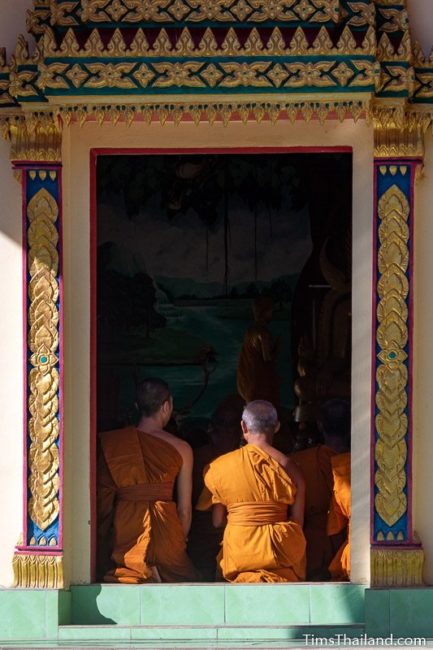
After a bit of group chanting the pariwat monks went to wait outside and one by one (not in seniority order since that had not yet been compiled) they went back inside to formally request to join pariwatsakam and confess their sanghadisesa failures thoroughly and sincerely: what, when, and why. (The thirteen sanghadisesa rules, including no deliberate discharge of semen, making unfounded accusations against other monks in order to get them disrobed, and attempting to create disharmony in the community of monks, is the second-most serious set of Buddhist monastic rules.) They may have also confessed to their own temple’s abbot before coming to Wat Ban Khok Nong Waeng for Boon Khao Kam, but it’s not necessary.
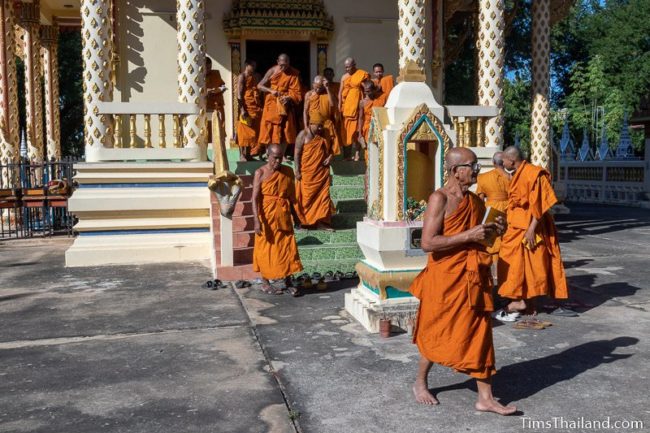
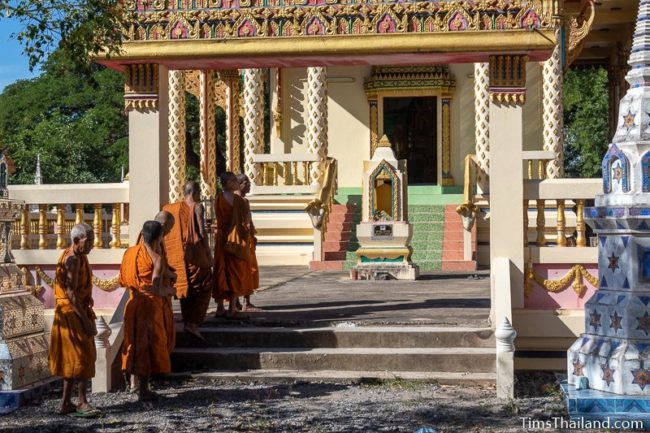
There’s no punishment given – joining the pariwatsakam assembly is their penance – but the ong suat monk, the head of the sangka and the only one who the offenders talk with, starts the purification process by reciting a chant in Pali, chosen based on their particular transgression(s). These short solo meetings went on for two hours.
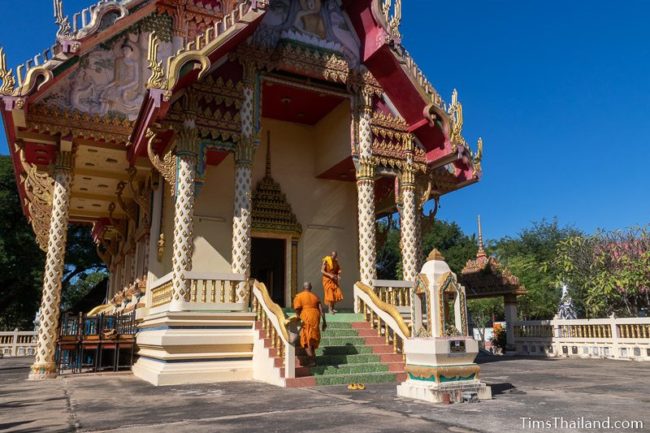
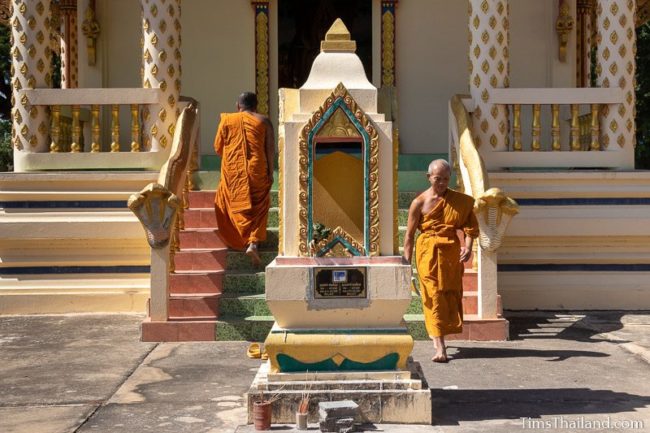
No lunch was served this day and the rest of the afternoon was free time for the pariwat monks. They generally stayed in the camp, some read and meditated, others chatted; many did some amulet shopping.
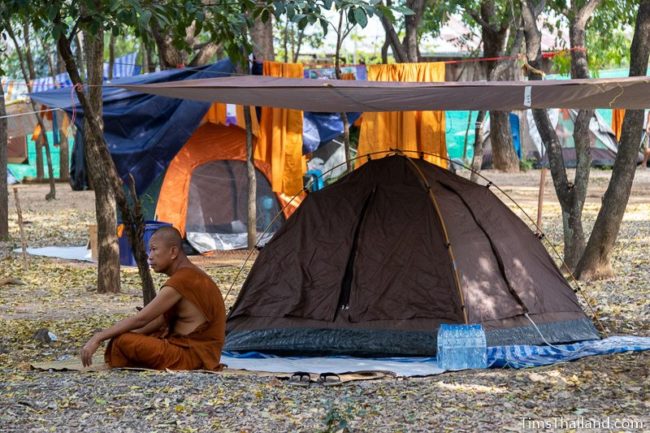
The cooks got back to work at 1pm, and at 4pm there was a second round of confessions for thirteen monks who’d arrived at the temple later in the day.
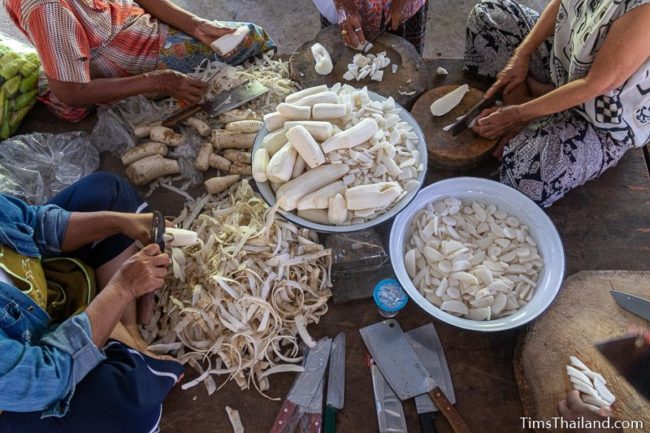
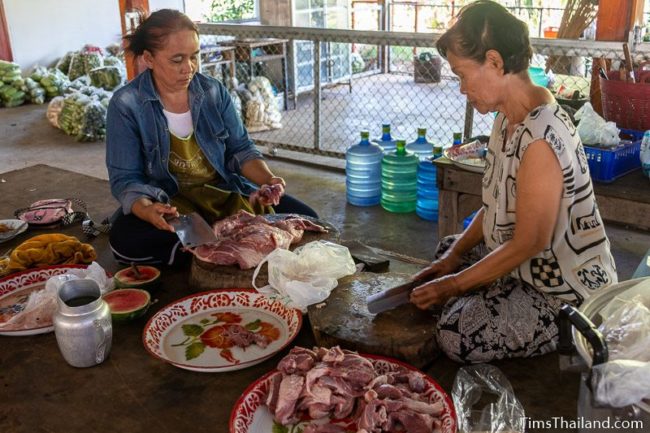
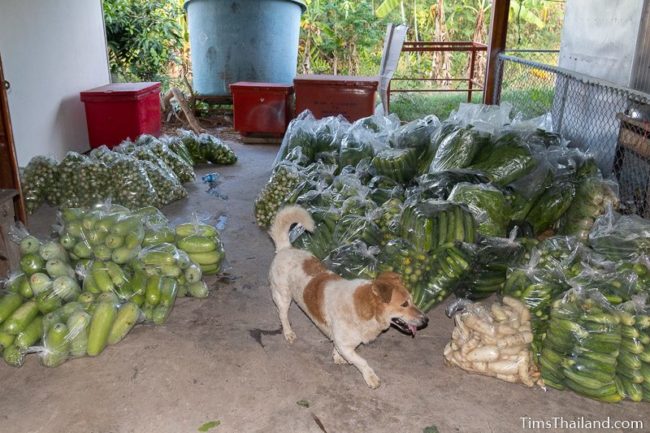
At 5.30pm, right around sunset, when the temple’s many chickens and guinea fowl were starting to roost, the gong was rung and the monks and mae/paw khao assembled at the lahn-tam for nearly two hours of chanting. While short chants are akin to prayers, long chanting like this is similar to meditation, and a part of the purification process. This was followed by a half-hour sermon about controlling desire – very relevant to Boon Khao Kam – and then another half hour of chanting, after which everyone was served water and soy milk.
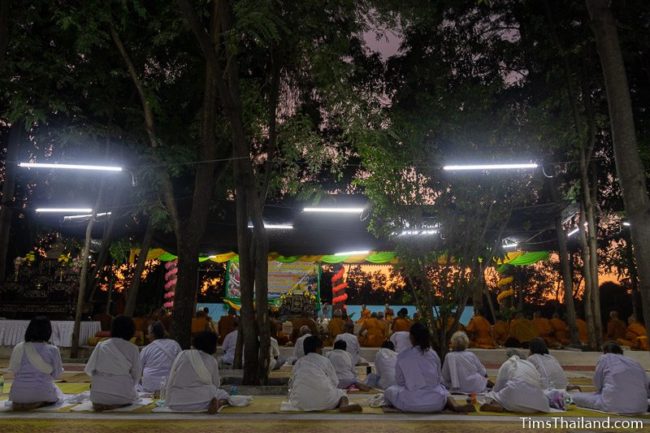
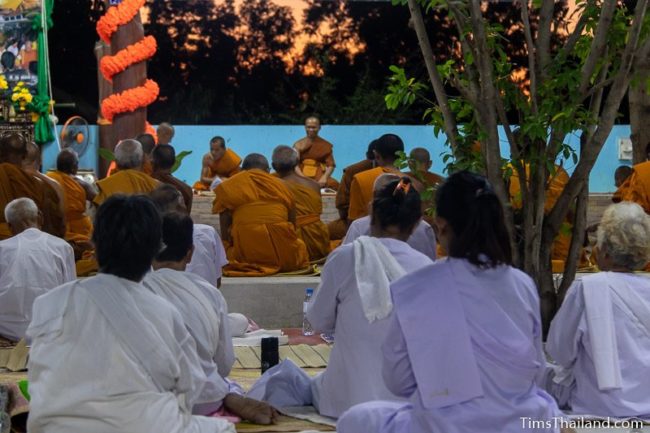
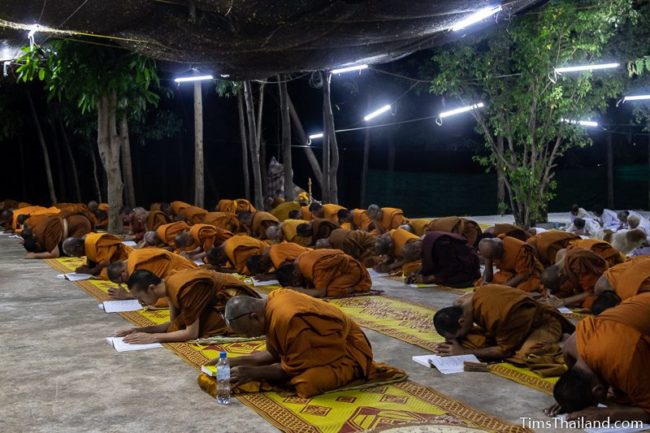
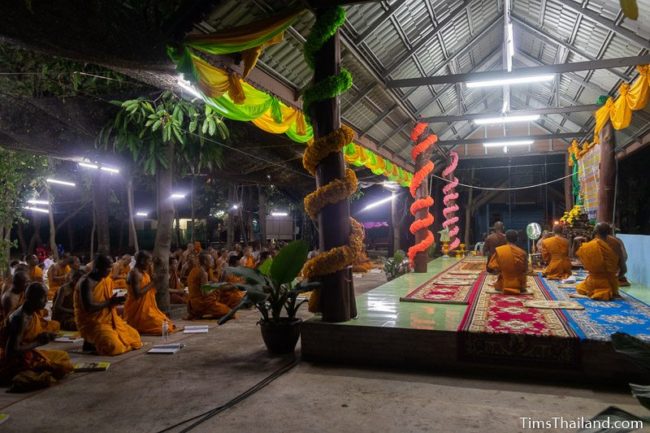
Then all the pariwat monks stood up and were called out by name to arrange a seating order by their time as monks – the eldest at the front. From then on they sat in this place during chanting and meditation. Starting the next day they wore tags with their rank to help them keep in order.
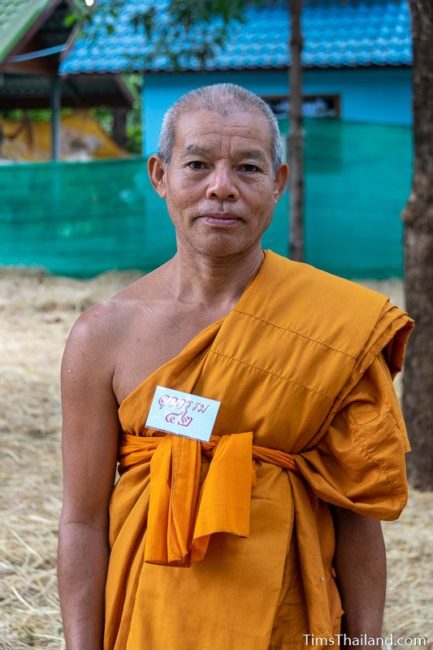
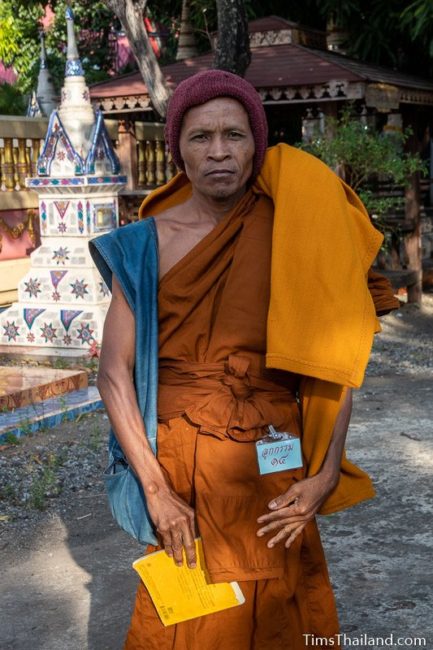
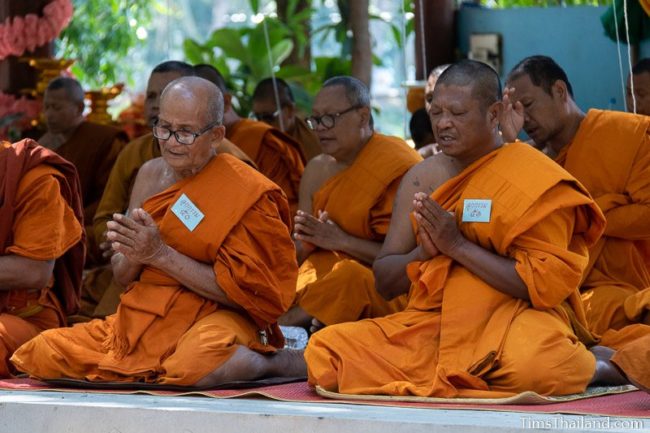
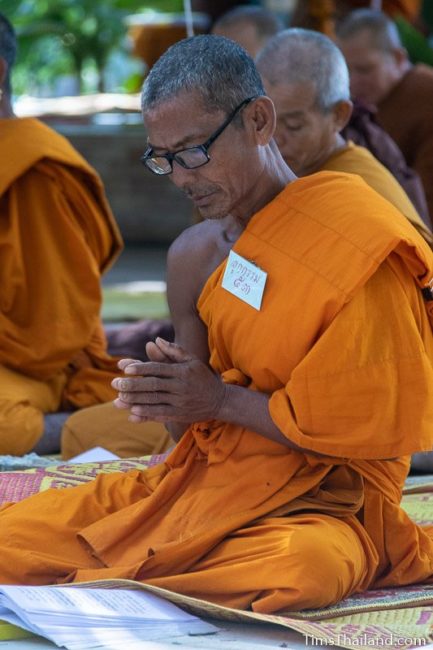
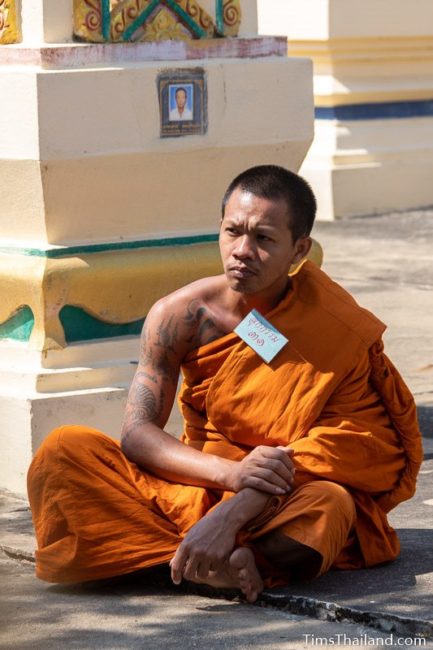
The abbot made a few practical announcement about the schedule for the following days and where to find things like coffee. Then after another short chant, the mae/paw khao left; and after a few more chants, so did the monks. At this time the pariwat monks formally bawk wat, ritually proclaiming their dedication to performing penance – bawk wat must be done for nine nights before their penance is over.